Columbia River Treaty
Edition: September 2021

Elementary students contribute to interpretive sign for Columbia River headwaters
Sep 28, 2021
This spring, a new interpretive sign was erected in Canal Flats, B.C. to highlight the significance of the Columbia River headwaters. The sign now stands in Tilley Memorial Park, at the south end of Columbia Lake, source of the Columbia River.
The project came together over the past three years, as students from Martin Morigeau Elementary School in Canal Flats worked with the Columbia Lake Stewardship Society (CLSS), Wildsight Invermere and local Indigenous partners.
“We began this project as a cross-curricular Social Studies and Science inquiry where students learned about Indigenous Peoples in the valley and their history of living near the Columbia River,” said Alyssan Gauthier, Principal of Martin Morigeau Elementary School. “Students learned about the importance of wetlands to our ecosystem, and plants and animals that are part of the river habitat.”
Their studies led to a connection with the Columbia Lake Stewardship Society, which was developing an interpretive sign for Tilley Memorial Park. Tracy Flynn of CLSS and the CLSS intern teacher Etienne Lombard offered to work with the students and give them space to share their newfound knowledge within the Society’s sign.
One panel is titled “History and Ecological Importance of the Columbia River Headwaters by Martin Morigeau Elementary School Intermediate Students.” It highlights the history and culture of the First Peoples of the Columbia Valley; dams on the Columbia River; salmon and their lifecycle; and the wetlands in Canal Flats.
Nancy Wilson, CLSS Chairperson, explained that the Society envisions Columbia Lake becoming an example of the balance that can exist between nature and the needs of local communities. “We are working to preserve the ecological health and water supply of Columbia Lake for present and future generations through scientific investigation, collaboration, and outreach.”
As the project evolved, the students met with Wildsight staff to glean more information about the Columbia Valley wetlands. They also met with local Indigenous partners.
“We worked with Laverna and Basil Stevens, Christine Warbrick and Mark Thomas from the Shuswap Band, Alfred Joseph from the Akisqnuk band and Bonnie Harvey from Ktunaxa Nation to learn more about the history of First Peoples in our valley,” said Gauthier. “Tisha Tardif, our school’s Aboriginal Education Support Worker at the time, supported students’ First People’s language learning using the Secwépemc and Ktunaxa First voices apps.” The interpretive sign reflects some of what students absorbed through this important exchange – it explains how the Ktunaxa built tipis (ʔa·kawutǂaʔnam), how the Secwépemc built pit houses (kekuli), and the importance of Ktunaxa and Secwépemc legends.
To generate interest in the sign and help raise funds, the students presented the information they had gathered at the Headwaters Trail during the Wings Over the Rockies festival in May of 2019.
Student Kyra Kruk said the best part of working on this project was “getting to share our hard work, because we worked so long on it, and getting to share our knowledge. The headwaters is water for many other rivers. There are several dams on the river that provide hydro-power for many people.”
Asked what she hopes people who see the sign will take away from viewing it, student Lucia Blanchard said, “To learn the importance of the headwaters and how we need to take care of it and the importance of salmon and our First Nations people to our land and our history. I just want to say thank you to our Ktunaxa and Secwépemc peoples.”
Kyra Kruk said, “I hope people will take this knowledge and inform other people about why the headwaters are so important to our ecosystem.”


